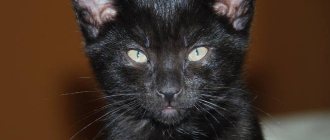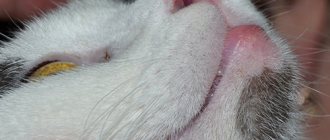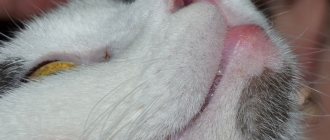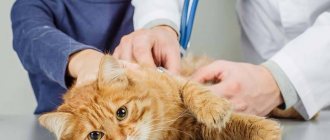Every pet owner suffers when their pet gets sick. The realization that he cannot help himself and regulate his condition on his own is depressing. I would like to help quickly and efficiently, but I don’t always have enough knowledge and experience. It is especially difficult when the cause of the disease is unknown.
One of the conditions that raises many questions among cat owners is a swollen cheek. The affectionate grimace is replaced by a pained expression on the face. There can be many reasons. The most popular are:
- Insect bites;
- Dental problems;
- Oral cancer;
If your cat's cheek is swollen, you should immediately visit a veterinarian. Having determined the cause of the animal’s health deviation, he will prescribe treatment. Many oral diseases can be treated quite successfully in the early stages. If therapy is ineffective or completely absent, the disease will inevitably develop to a severe pathological condition. You can completely avoid the occurrence of such problems by conducting regular preventive examinations of the animal at the veterinarian.
Acne
If you are wondering why a cat's cheek is swollen, then the reason may lie in this disease.
On your cat's lips and chin there are large sebaceous glands that produce keratin. If its amount becomes too large (usually due to other diseases or poor nutrition), then the element clogs the sebaceous glands, in the place of which acne appears. They look like ordinary bumps, leading to swelling of the cat's cheek.
Usually it is easy to determine pathology by eye. The treatment is quite simple, and if you start it on time, then no problems will arise later. It is necessary to treat the skin with antibacterial cream. In the most advanced cases or recurrent illness, antibiotics may also be needed. In this case, therapy becomes more complex and lasts up to three weeks.
Diagnosis and identification of causes
In some cases, the owner can independently determine the reason that the lower lip is slightly enlarged and swollen. This is possible in cases where it is reliably known about an injury, an insect bite, or the presence of an allergic reaction.
In most cases, a simple visual inspection of a cat with a swollen lip will be sufficient. The doctor may also take a sample of biomaterials for analysis to determine the presence of a bacterial or fungal infection. You may also need a blood test to get a more complete picture of your cat's health.
If there is a suspicion of swelling due to a benign or malignant neoplasm, a biopsy, ultrasound and x-ray examination will be required. These measures are necessary to confirm or exclude the presence of tumors, determine their nature, as well as the stage of the disease.
Swollen lips in a cat can indicate a variety of processes in the animal's body. This alarming symptom should not be ignored. It is better to immediately rule out the presence of a serious pathology than to try to cope with a serious illness later. Owners should not be faced with the question of whether to see a doctor or not.
The choice of treatment method depends directly on why the lip is swollen. You should not prescribe treatment for an animal yourself, since the wrong choice of method and means may not only not improve the pet’s condition, but also significantly worsen it.
If you were able to independently (and accurately) determine the cause of the swelling on the lip, you should not personally prescribe treatment for your pet. Consultation with a salesperson at a veterinary pharmacy may also not be sufficiently informative and useful. Only an experienced and qualified specialist should select the optimal method of treating a cat with a swollen lip. When prescribing treatment, the history of previous diseases and treatments, characteristics of the breed, sex and age of the animal, etc. should be taken into account.
What to do and how to treat a cat’s lower lip depends on the reasons why it is swollen:
- Injuries. Treatment is symptomatic. The choice of specific method depends on the extent of the injury. For a slight bruise, it will be enough to treat the skin with an antiseptic. In more severe cases, you should consult a doctor, as stitches may be required at the wound site.
- Swelling due to dry food. No treatment required. To get rid of swelling, it is enough to start giving your cat dry food with a softer consistency or completely abandon it.
- Bite of another animal. The injury site must be treated with an antiseptic. If a cat is bitten by someone else's animal, or an animal that lives on the street, it is advisable to seek medical help and get vaccinated against rabies. Stitches may be required.
- Insect bite. You need to treat the bite site with an antiseptic and try to remove the sting. Then apply a cold compress and hold for several minutes. If your cat has a fever and weakness, you should take your pet to a veterinary clinic.
- Allergy. If you have an allergic reaction, only a doctor can prescribe an antihistamine. It will also help determine the required dose. Even if a cat is prescribed a “human” drug, its dose will be 2, 3 or 4 times less for humans. If an allergy due to parasites is suspected, the cat should be tested for helminths, ear mites, and examined for fleas and ticks.
- Viral infection. At the first suspicion of a viral infection, an animal with a swollen lip should be shown to a veterinarian. The cat will be prescribed antibiotics.
- Tumor or cyst of the salivary glands. The cyst is eliminated by puncture and subsequent removal of its contents. In some cases, when the puncture does not bring the desired result, it may be necessary to remove the salivary gland.
- Malignant tumor. Treatment is only surgical. In severe cases, it may be necessary to remove surrounding tissue or the entire lower jaw.
- Acne. Only a veterinarian can prescribe treatment. First of all, it should be aimed at slowing the progression of the disease. Acne is then treated in a similar way as in humans.
You should not delay going to the doctor and starting treatment. Timely assistance to your pet is a guarantee of its health and long life.
Insect bite
Quite often, cats get injured through their own fault. For example, by hunting a bee or a wasp and achieving success. Of course, the poison contained in the sting leads to an inflammatory reaction. As a result, the cat's cheek was swollen and his eye was swollen. It looks really creepy. But it usually goes away in a few days or even hours, without causing unnecessary trouble to either the cat or the owner.
The situation is much worse with several bites or allergies. This can lead to the most dire consequences. To avoid them, you need to use an antiallergic drug - Claritin or Suprastin.
Possible reasons
Tumors on a cat’s face can be the result of:
- Insect bites.
- Acute allergies.
- Pathologies of the oral cavity.
- Neoplasms.
It is necessary to consider each of the listed reasons in more detail in order to understand the nature of the edema.
Insect bites
Cats, especially young ones, are playful and curious creatures who often do not know when to stop. By nature it is a predator, so insects always cause natural interest in cats. At the same time, not all insects are safe, so curiosity often destroys a cat, and bites are inevitable.
Bees, wasps and some types of spiders are poisonous, and their venom contains a powerful neurotoxin that can cause a severe allergic reaction. The smaller the animal's body weight, the more dangerous the consequences of playing with the insect. Sometimes bee or wasp venom can cause paralysis.
The following symptoms will help distinguish an insect bite from other pathologies:
- the appearance of a characteristic small edema on the animal’s cheek;
- visible skin puncture site;
- hyperthermia of the epidermis around the bite site;
- pain and itching on palpation.
The listed symptoms are a favorable prognosis. This reaction occurs if a little poison gets into the blood, and the animal does not develop an allergy. In this case, it is enough to apply a cold compress to the bite site, wrapping an ice cube in a cloth to avoid frostbite, and remove the sting if it is a bee sting.
In cases where the cat was completely careless and a lot of poison entered the body, an acute allergic reaction develops. The swelling quickly increases, spreads to the larynx and can lead to respiratory paralysis. This requires urgent medical attention, otherwise the animal may die.
Snake bite
Cats also often become victims of snake bites. Of course, this is not typical for pets living in an apartment and not going outside. But for cats who live in the house or come to the country in the warm season - it’s fine.
Of course, the greatest danger comes from the bites of poisonous reptiles. This may well lead to shock and even death of the animal. However, even the bite of non-venomous snakes poses a certain threat. Primarily due to the fact that during a bite a wound is formed, into which infection from the snake’s teeth enters. Because of this, a focus of inflammation arises, which can lead to dire consequences.
To prevent this from happening, you need to use antibiotics. But there is no particular rush here - it is enough to take action in the next few hours.
But if you are bitten by a poisonous snake, you need to act as quickly as possible. Alas, not every home medicine cabinet has an antidote, so it is advisable to immediately visit a veterinarian. Along with the antidote, he may give an injection of diphenhydramine. After the shock has been relieved and the effects of the poison have been eliminated, the doctor may also prescribe broad-spectrum antibiotics to eliminate the possibility of inflammation.
Treatment
After making a diagnosis, the doctor will prescribe appropriate treatment aimed at eliminating the cause of the disease and reducing symptoms:
- Acne. For minor acne rashes, treating the affected area 3 times a day is sufficient. Use a weak iodine solution or antibacterial soap. In more serious situations, Chlorhexidine or hydrogen peroxide is used. When an infection occurs, antibiotics are given orally, and the affected area is lubricated with Mupirocin and Bactroban.
- If a cat's cheek is swollen due to an allergic reaction, then treatment consists of eliminating the irritant. The cat is transferred to diet food or hypoallergenic food. Antihistamines: Fexofenadine, Bicarfen, Diazolin, Soventol.
- Abscess - the doctor performs an autopsy followed by treatment with an antiseptic. A drainage is inserted into the resulting empty cavity. After removal, antibiotics and pain relievers are given.
- Cancer tumor. Treatment options depend on the stage of spread and location. If the animal can be saved, then surgical removal, chemotherapy or radiation is performed.
- Flux – prescription of antibiotics. After the swelling has reduced, dental treatment is carried out, tartar or plaque is removed, and, if necessary, removal.
- Inflammatory processes - corticosteroids, non-steroidal anti-inflammatory drugs.
If you notice swelling in your pet's cheek, do not hesitate to go to the veterinary clinic. This condition is usually caused by inflammation, which requires urgent treatment.
Cancerous formations
One of the most difficult reasons why a cat has a swollen cheek is cancer. Moreover, about 3% of tumors appear in the oral cavity. Of course, this leads to difficulties with food consumption, and in some cases does not allow the animal to breathe normally. At the same time, the cat is drooling heavily from its mouth.
You need to act quickly and decisively. Otherwise, the risk of lung damage remains - the tumor produces metastases, which makes treatment almost impossible.
Most often, such problems arise in animals living with owners who have the habit of smoking at home. Unfortunately, furry pets are very sensitive to toxic substances contained in cigarette smoke.
Another factor that increases the risk of malignant tumors is excessive consumption of canned food. Yes, according to veterinarians, if canned food accounts for more than 50% of the diet, the animal may well develop cancer.
In most cases, such problems occur in older cats - 10 years and older. But sometimes this can happen to younger animals too.
Treatment is determined by the doctor depending on a number of factors. Surgical removal of the tumor with radiation and chemotherapy is usually prescribed.
Swollen cheek of a cat photo
Anaphylactic reactions
An anaphylactic reaction is an acute immunopathological process that develops in a matter of minutes. If suddenly, literally before your eyes, your cat’s cheek is swollen, you should urgently analyze the latest events, identify a possible allergen and consult a doctor. Perhaps the pet was bitten by a wasp.
The causes of anaphylaxis are:
- Insect poisons.
- Food.
- Aggressive chemicals (if ingested).
- Medicines.
The swelling starts from the muzzle. It quickly spreads to the cheek, lips and area around the nose. At the same time, the animal’s eyes become very watery and breathing is impaired. A blistering rash may appear within minutes. The danger of this condition lies in the risk of paralysis of the respiratory system.
Typical symptoms other than swelling:
- diarrhea;
- severe vomiting;
- muscle cramps;
- intermittent breathing;
- shock.
The most dangerous reactions are those that develop in response to the vaccine. The drug administered by injection is difficult to quickly remove from the body, so anaphylaxis rapidly progresses and can lead to the death of the animal.
Epinephrine is used to stop an attack. It is administered only by a doctor. Additionally, it is necessary to stabilize vital signs, which is impossible to do at home, therefore, if swelling increases rapidly, you should urgently take the animal to the veterinarian, since with anaphylaxis, literally minutes count.
Dental disease and swelling on the muzzle
Oral infections lead to swollen cheeks in pets. The cause may be advanced caries, gum abscess, or oral trauma.
If a cat's cheek is swollen and the eye is festering, the cause is acute inflammation of the gums - gumboil or abscess, depending on the depth of the damage to the mucous membrane. Touching the inflamed area will cause severe pain in your pet. Associated symptoms: general and local fever, intoxication, refusal of food and water.
Purulent cavities must be opened and cleaned. The suppuration should not be allowed to open on its own - if the contents of the abscess enter the general bloodstream, sepsis may develop, which can be fatal. The procedure for cleansing the oral cavity is carried out by a doctor, so you cannot delay a visit to a specialist.
Benign and malignant neoplasms
A cheek tumor can be either a relatively harmless lipoma (fat) or a malignant neoplasm. Benign and malignant neoplasms are diagnosed mainly in cats over 7 years of age; young animals rarely encounter such pathologies.
Oral cancer progresses rapidly and is fatal. In this case, it is impossible to make a diagnosis on your own; it is necessary to examine the cat at a veterinary clinic. Based on the results of the examination, the doctor will decide on drug treatment or removal of the tumor.
Abscess
If the cat has a swollen cheek and under the eye, and there is a swelling here that is quite hot, but soft, then most likely you are dealing with an abscess. The skin was damaged by an animal or insect bite and the wound became infected. The body begins an inflammatory process - the wound fills with pus. In general, such a tumor causes a lot of problems for the animal, reducing immunity and worsening well-being. Sometimes it becomes painful - the cat breaks out when the owner touches the problem area.
In advanced cases, the infection can develop, affecting the entire body, starting with the ears and joints.
An experienced veterinarian can easily clean the wound, removing pus and drying the infection. Special drainage will avoid re-accumulation of pus. At the same time, antibiotics and painkillers may be prescribed.
Associated symptoms
Apart from the presence of a lump under the skin, the animal may not show any other symptoms. Wen and benign neoplasms, as a rule, do not manifest themselves in any way.
In some cases, the tumor constantly increases in size, as a result a large lump grows and begins to interfere with the cat and cause inconvenience. In such cases, measures should be taken as soon as possible.
Firstly, the rapid growth of a tumor is a dangerous sign. And secondly, the cat will try to get rid of the irritating factor by scratching or trying to rip off the bump in some way. This can lead to aggravation of the pathological process, injury, and bleeding from the damaged area.
In some cases, when a cat develops a gradually enlarging lump under the skin, a number of additional symptoms are observed. Suppuration or an inflammatory process may be accompanied by hyperemia of the affected area, skin tension, swelling and severe pain. Also, due to the activity of pathogenic microflora, symptoms of intoxication increase: fever, weakness, and sometimes nausea and vomiting.
Allergic reactions can be accompanied by extremely unpleasant itching sensations for the cat. Itchy skin provokes scratching, damage to the skin and aggravation of the problem.
Flux
Another problem that can lead to swelling on your cat's face is gumboil or dental abscess. This phenomenon is quite common, primarily causing problems for older cats. Usually caused by a broken or rotten tooth, harmful bacteria enter the gum through the wound, leading to swelling and pain.
This can be easily avoided with regular hygiene - brush your cat's teeth at least several times a month.
At the same time, the animal loses its appetite, its face swells, its health worsens, and a strong unpleasant odor emanates from its mouth.
Properly selected antibiotics can reduce swelling while also removing pus. But you also need to deal with the cause of the problem. The tooth is usually removed to avoid re-infection.
Other reasons
Swelling of the lower jaw and lips in cats can be caused by household injuries. An older cat may accidentally scratch his lip when chewing hard food. As a result, it will swell and upon external examination it will appear that it is a swollen jaw. Burns to which animals that like to chew wires or taste food on the stove are also susceptible. Despite the apparent harmlessness, household injuries should be treated. Any wounds and injuries are treated with an antiseptic; for burns, you should use a special product to speed up healing.
Sometimes owners may notice that the cat has a lump on his chin. It has the shape of a ball. Without examination and consultation with a veterinarian, it is very difficult to understand whether such a phenomenon will become a symptom of a dangerous disease or whether this sign is completely safe for the health of the pet.
To understand the reason why a cat's chin began to swell, you need to pay attention to the nature and size of this bump. The diagnosis will depend on this and, accordingly, treatment will be prescribed.
The lump can be of several sizes:
- Small ones. Very often these are simple pimples. They can appear due to the lack of, as well as violation of personal hygiene by the cat. That is, for some reason the animal did not wash itself well. This causes the skin to lose its protective functions, resulting in clogged pores. To make the bumps go away, you need to cut the hair on the cat's chin and wipe the area with hydrogen peroxide several times a day.
- Average. Their diameter ranges from 0.2 to 0.5 cm. Usually a lump of this size in a cat is called a subcutaneous boil. It develops like a pimple. If the owners did not promptly pay attention to the bump on the chin and did not treat it, then the pet’s condition may worsen. In addition to the increased size of the pimple, suppuration is added. In this case, you need to immediately take your pet to the veterinarian; piercing the boil yourself or waiting for it to go away is highly not recommended.
- Large ones. This may indicate the development of boils in a cat that were caused by subcutaneous parasites. Initially, the cone becomes red, but if the disease is severely neglected, it acquires a yellow or green tint. When touching boils, the cat experiences severe pain, so most often the animals simply do not give in to their hands. You should definitely contact your veterinarian quickly for help to prevent the infection from getting worse.
A lump on a cat's chin may be a normal lymph node. It must be palpable well. But this is still not the norm for the animal. Most likely, he had a weakened immune system or vitamin deficiency. To rid your cat of such a lump, you should change his lifestyle. For example, give up artificial food and return to natural food.
Causes of the disease
Experts can give a dozen different reasons why a cat’s lower lip could be swollen. Some of them are completely harmless and go away on their own, others can be treated at home, and there are others that can lead to a fatal outcome for a member of the feline family. Below we will discuss the most common factors that can cause a pet's lower lip to swell:
Burn wounds. There are thermal, electrical and chemical burns. The first option is rare, since cats rarely eat food that is too hot for them. However, your pet is capable of licking a hot frying pan if it smells delicious. Electrical burns occur because the animal likes to chew on live wires. Chemical lesions leading to swelling of the lower lip can be caused by household chemicals or animal hygiene products. A common symptom for each of them is severe inflammation located in the lip area. Insect bites. The lip may become swollen if it is stung by a wasp or bee. The owner is able to detect, in this case, the remaining sting. Over time, severe swelling occurs at the site of the lesion. Lip injuries. Occurs if the cat has a metal food bowl with sharp, uneven edges. In parallel with this, gum damage can also be detected. An animal can also get injuries to the soft tissues of its lower lip during a fight with its fellow tribesmen on the street. Oncology localized on the upper or lower lip. Rarely encountered, but extremely dangerous. In veterinary medicine, neoplasms of this kind are called squamous cell carcinoma. According to statistics, they are more often malignant, which means they are capable of metastasizing. Additional signs characterizing this disease include a putrid odor from the cat’s mouth, ulcers on the oral mucosa, and excessive salivation. Over time, the lymph node closest to the tumor becomes inflamed. A benign tumor can be removed surgically, but a malignant one, unfortunately, leads to death in 90% of cases. Allergic reaction. If the lip is inflamed for this reason, then the first thing the owner needs to do is to detect a harmful allergen that negatively affects the pet’s body. This could be plant pollen, components of a pet’s diet, household chemicals, bites of blood-sucking parasites, pharmaceuticals. If the irritant cannot be identified on your own, you should seek help from a qualified specialist. Industrial feed. If the lip is swollen after the cat was switched to dry food, then rest assured that this is the reason. This is especially true in cases where the animal previously ate natural food. The hardness of industrial feed provokes the appearance of calluses on the delicate tissue of the lip, where inflammation occurs. Gingivitis can be another of the many factors that cause a cat to have a swollen lower lip. Its striking symptoms are the cat’s bad breath, bleeding gums, and an orange border appears around the pet’s teeth. If the owner does not react promptly, the cat is in danger of losing a tooth completely. In addition, gingivitis “walks” hand in hand with such terrible diseases as diabetes and liver failure. Stomatitis in a cat, caused by the harmful activity of a fungus that has entered the oral cavity, can be determined by the fact that the upper lip is swollen. In this case, an additional sign is the formation of white plaque on the mucous membranes of the animal. This pathology can be caused by a decrease in the cat’s immunity or long-term treatment with certain pharmaceuticals. Calcivirosis in cats also leads to swelling of the lips and mucous membranes of the mouth. The disease has an infectious etiology, additional symptoms include lameness, mouth ulcers, conjunctivitis and loss of appetite. Requires surgical and complex therapy. Acne, another name is subcutaneous pimple. It occurs due to disruptions in the hormonal system, insufficient oral hygiene of the pet, and excessive activity of the sebaceous glands. Located in the corner of the lips, it does not cause much concern to the cat. You can remove a pimple yourself; to do this, wipe the affected area with antibacterial soap, and then apply an ointment that contains benzoyl peroxide.
It is important that the cat does not lick the medicine, and that it stays on the pimple for at least 5-6 minutes. Then wash off the remaining ointment with Chlorhexidine solution
What to do at home
The owner must provide his pet with the most comfortable living conditions and strictly follow the veterinarian’s instructions. You should not self-medicate, as this can aggravate the situation and cause irreparable harm to the cat’s health.
You can alleviate the suffering of a fluffy with the help of a soda solution or decoctions of medicinal herbs that have a disinfectant and antimicrobial effect. However, traditional methods cannot replace traditional treatment and are used as additional measures.
A decoction of chamomile, oregano, and strawberry leaves has worked well. You need to boil 1 teaspoon of the dried plant, pour a glass of boiling water, and cook over low heat for 10 minutes. Then strain the broth, cool and use to wipe the animal’s mouth.
During gingivitis, a cat usually refuses to eat, since even a small, barely chewed piece causes her pain. However, to defeat pathology, the body needs strength. Your four-legged pet should be fed with special soft food intended for weakened cats, pureed meat and vegetables, meat or chicken broth.
Prevention
Moderate production of clear tears is normal for many breeds and therefore should not be a cause for concern. To maintain your pet’s health, it is important to carry out preventive measures:
- regularly treat your eyelids with hygiene lotion, which can be bought at any pet store;
- Long-haired breeds must undergo an additional grooming procedure. When blinking, long hairs touch the eyeball, which stimulates the lacrimal gland;
- try not to smoke in the room where the animal lives, regularly ventilate, wipe off dust, and do wet cleaning.
In addition, it is important to systematically give your pet medications for helminths, as well as monitor proper nutrition. All these measures will help keep your eyes clear and save you from many problems.
Description of possible causes
If a cat’s cheek is very swollen and its eyes begin to swim, then it is better not to wait for improvement, but to immediately take the pet to a veterinary clinic, as there is a possibility of developing anaphylactic shock.
It must be remembered that this symptom is characteristic of the following pathologies:
Allergy
Mainly in decorative breeds due to poor nutrition or after taking antibiotics. Almost always the cheek swells right before your eyes. Swelling may spread to the eyes and nose. Watery eyes and runny nose also appear.
Immediate use of antihistamines (Tavegil, Suprastin, Fenistil) and hospitalization of the animal are indicated. Less commonly, such symptoms can be caused after contact with plants in the spring and summer. You also need to know which house plants are not suitable for your cat, as it can be poisoned by the juice that comes from broken leaves.
Allergic swelling in the muzzle area should be treated very carefully, since the nasopharynx is nearby and there is a possibility of death through suffocation.
Insect bites
If a cat's cheek is swollen on one side, then it is necessary to carefully examine this area to identify a possible bite. As a rule, this reaction appears after a wasp or bee sting.
In some cases, the swelling can spread higher, causing the eyes to become swollen. Don't forget about the sting that may stick out from the lesion. It must be removed (using tweezers).
In most cases, swelling subsides on its own within a few hours, rarely lasting more than a day. If swelling is large and there is a risk of suffocation, urgent hospitalization of the pet is necessary. If the moment of the bite comes into the owner’s field of vision, then you can immediately give the animal half a suprastin tablet to reduce possible symptoms.
Tooth root abscess
Often found in older individuals. If a cat's tooth has broken off, but the root has not been extracted, then there is always a risk of developing an inflammatory process. At best, the gums will turn red, at worst, the cheek will swell. Moreover, in some cases, the swelling can be so severe that the eyes even become swollen.
Here you will need the help of a dental surgeon, who must open the abscess, clean it of pus and remove the rotten root from the gum.
Remember that the gums will become inflamed until the rotten root is removed. To avoid dental problems in the future, you need to regularly remove tartar and avoid soft foods.
Cyst
Unlike abscesses, it can occur even on completely healthy teeth. The appearance of a cyst can be triggered by the entry of a foreign body into the gum (usually bones or wood chips). As the process progresses, a hard lump appears on the gum, from which pus comes out. If this does not happen, the cheek may puff out.
To solve the problem, an x-ray is taken to determine the size and location of the cyst. If it is localized on the root of the tooth, then there is a high probability that it will have to be removed, even if outwardly it looks absolutely healthy.
If you do not contact a surgeon in time, the cyst becomes inflamed and an abscess forms at the site of the lesion.
Fistula
Occurs at any age. It looks like a hole in the gum, from which blood and pus ooze. It may appear after an abscess or cyst. The entry of a foreign body into the gum can also trigger the appearance of a fistulous tract.
A distinctive feature is pain and long healing. In severe cases, the cat's cheek may become very swollen and may bleed from the affected area. You cannot cope with a fistula on your own, since it is necessary to look for and eliminate the root cause that provoked its appearance. To do this, you will need an x-ray of the jaw to rule out a cyst or abscess of the tooth root and the presence of a foreign body in the gum.
After eliminating the root cause, anti-inflammatory and healing drugs are selected. Thorough sanitation of the oral cavity (chlorhexidine) is also indicated.
Malignant formations
They can affect the oral mucosa (sarcoma) and the jaw bone (squamous cell carcinoma). They are not common, mainly in individuals over the age of 12 years.
The prognosis is unfavorable, since the tumor is located in a hard-to-reach place and it is not possible to remove it using healthy tissue. Depending on the stage and size of the tumor, radiation and chemotherapy may be used. Maintenance therapy is also selected.
Click to see photo
Treatment principle
Any purulent wounds are treated with antiseptics and antibiotics. The damage can be disinfected with miramistin, chlorhexidine or hydrogen peroxide. With antibacterial therapy, not everything is so simple. For abscess and fistula, injection of antibiotics is practiced; drugs are selected only by a veterinarian after examining the cat.
If you find a large wound on your cat's face, you need to trim off the hair around the injury and wash the affected area. Then you should treat the wound with an antiseptic. To reduce inflammation and accelerate tissue repair, Levomekol is placed directly into the wound. Treatment is carried out 3-4 times a day. To prevent the cat from licking the ointment and scratching the wound, you can use a special veterinary collar.
It is recommended to open a large abscess surgically. This significantly speeds up recovery. The purulent cavity is incised with a scalpel, then a drainage is placed to remove the contents.
A fistula should only be treated by a specialist. In this case, it is necessary to identify the source of inflammation, which may be located in the jaw or pharynx. Dead tissue around the wound is excised with a scalpel, and drainage is installed into the cavity to remove purulent masses. If the inflammatory process began due to problems with the teeth, they are removed.











